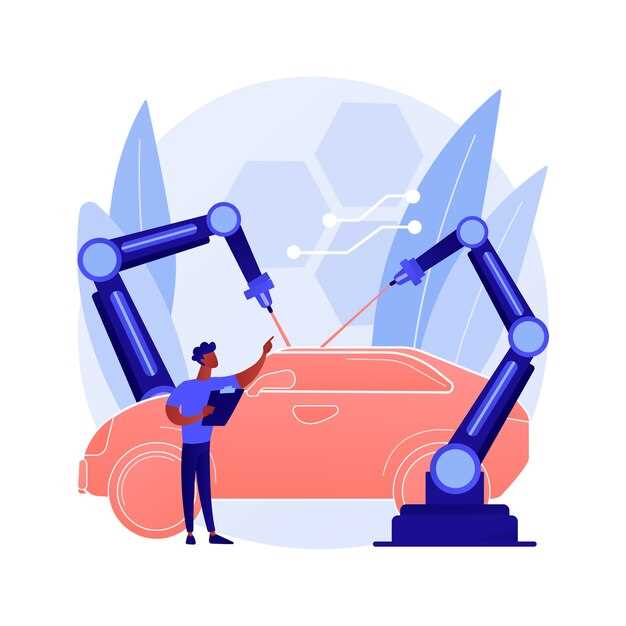Adopt 3D printing technology to transform your automotive production processes. This approach significantly reduces material waste and streamlines manufacturing time, creating a more sustainable and cost-effective model. Studies reveal that companies implementing this technology can experience up to a 70% reduction in lead times, allowing for faster market responsiveness.
Utilizing 3D printing facilitates the creation of complex geometries that traditional manufacturing methods struggle to achieve. By leveraging this capability, engineers can produce lightweight components that enhance vehicle performance and fuel efficiency. For instance, the ability to refine designs rapidly can lead to the development of parts that are not only lighter but also stronger, thus improving the overall safety of end products.
Another advantage is the potential for mass customization. 3D printing allows for the production of unique vehicle parts tailored to individual customer specifications without incurring prohibitive costs. Brands like BMW and Ford are already integrating this into their production lines, focusing on customer satisfaction through personalization while maintaining efficient manufacturing practices.
Investing in 3D printing aligns your business with future trends in automotive production. As supply chain pressures mount globally, the ability to localize manufacturing and reduce dependency on overseas suppliers provides a competitive edge. Start exploring this technology today to enhance your operational capabilities and meet the evolving demands of the automotive market.
Reducing Time-to-Market with Rapid Prototyping
Adopt rapid prototyping techniques to drastically shorten the time it takes to bring automotive designs to market. By utilizing 3D printing, development teams can create functional prototypes within days, facilitating faster iterations and adjustments. This approach minimizes delays often associated with traditional manufacturing, where molding and tooling processes can span weeks or months.
Utilizing computer-aided design (CAD) software in conjunction with 3D printing allows for immediate testing of design concepts. When issues arise, teams can modify the designs and produce new prototypes quickly. This iterative process reduces the risk of costly errors later in production, which can lead to unexpected delays.
Consider integrating in-house 3D printing capabilities. This investment not only speeds up prototype creation but also allows for greater control over the design process. Quick access to prototypes enables engineers and designers to collaborate more effectively, sharing insights and making real-time adjustments based on testing results.
Engage with suppliers who specialize in rapid prototyping services for complex components. Their expertise can enhance production timelines, particularly for intricate parts that require specialized knowledge. Partnering with these suppliers can also provide access to a variety of materials, allowing for further innovation and testing of different design specifications.
Additionally, incorporating feedback loops from stakeholders during the prototyping stage improves alignment with market expectations. Gathering input from sales and marketing teams early ensures that prototypes meet customer desires, streamlining the product development process and reducing the likelihood of revisions late in the game.
Leverage rapid prototyping to not only accelerate production timelines but also create a culture of innovation within your automotive operations. By fostering collaboration and leveraging advanced technologies, your team can consistently introduce new models and features that resonate with consumers, keeping your brand competitive.
Cost Savings through Additive Manufacturing Techniques
Implementing additive manufacturing (AM) in automotive production significantly reduces costs. This approach allows for more efficient use of materials, leading to less waste. Traditional manufacturing methods often result in substantial material scraps, while AM produces components layer by layer, minimizing surplus.
Here are specific areas where cost savings are realized:
- Tooling Reduction: AM eliminates the need for expensive tooling. Producing complex parts that traditionally require multiple molds can be accomplished with a single additive process, reducing upfront costs.
- Shorter Lead Times: 3D printing accelerates production cycles. Fast prototyping means automakers can test designs quickly, shortening time-to-market significantly. This agility contributes directly to departmental efficiency and cost reduction.
- Lightweight Components: By using AM, manufacturers can create lightweight parts, enhancing vehicle fuel efficiency. Reducing weight saves on fuel costs and improves performance, providing a further financial advantage over the vehicle’s lifespan.
- Localized Production: AM paves the way for localized manufacturing, cutting transportation costs. Producing parts closer to assembly plants minimizes logistics expenses and enhances supply chain resilience.
- Customization and Reduced Inventory: AM enables customization without additional costs. This flexibility means reduced inventory needs, lowering storage costs and the risks associated with excess stock.
Investment in AM technology offers automakers the opportunity to streamline their processes. Initial expenditures on machines and materials are often offset by the long-term savings across various operational aspects. Managing these transformations strategically can lead to prosperity in an increasingly competitive marketplace.
Customizing Vehicle Components for Enhanced Performance
Begin by identifying key performance areas in your vehicle. Focus on components like the exhaust system, intake manifolds, and suspension systems. These parts significantly influence speed, handling, and fuel efficiency.
3D printing allows for the creation of bespoke components tailored to specific demands. For example, redesigning an exhaust system with advanced materials can reduce weight and enhance exhaust flow, leading to improved engine performance. Utilize CAD software to create models that optimize geometry based on aerodynamic principles.
Expanding your intake system with custom-designed air filters or plenums increases airflow, providing your engine with more oxygen and enhancing combustion efficiency. 3D printing makes it feasible to produce complex shapes that traditional methods cannot achieve.
Suspension modifications can also be more precise. Adapting strut mounts or control arms through 3D printing allows you to fine-tune ride height and handling characteristics. By personalizing these components, you improve the vehicle’s stability, cornering performance, and comfort.
Collaborate with engineers to ensure your modifications meet safety regulations. Conduct simulations to test durability and performance under various conditions before moving to production. This step mitigates risks associated with custom parts.
Finally, consider iterative testing. Compile data on each component’s performance and refine designs based on feedback. This approach leads to continuous improvement, guaranteeing that your custom components not only enhance performance but also stand the test of time.
Streamlining Supply Chains with On-Demand Production
Implement on-demand production to reduce inventory costs. This method allows manufacturers to print components as needed, minimizing the risk of surplus and waste. Assess the most common parts that require frequent replacement or modification, and consider 3D printing these items. For example, creating custom brackets or housings on demand can dramatically streamline operations.
Integrate 3D printing with your supply chain management software to enhance visibility and responsiveness. Use real-time data to forecast demand accurately, ensuring that production aligns with actual needs. This strategy can significantly shorten lead times and improve customer satisfaction.
Optimize your materials by selecting reliable and high-quality resins or filaments that cater to specific automotive applications. Utilizing advanced materials can improve the durability and performance of printed parts, making them suitable for end-use in vehicles.
Encourage collaboration with suppliers who are also leveraging 3D printing. Building partnerships can lead to shared resources and knowledge, ultimately enhancing your production capabilities and reducing costs. Access to local 3D printing facilities can accelerate prototyping and testing phases for new designs.
Implement training programs for employees on 3D printing technologies. Equip your workforce with the necessary skills to operate printers and conduct maintenance. A knowledgeable team can quickly address any issues that arise, keeping production smooth and uninterrupted.
Regularly evaluate your on-demand production processes. Analyze performance metrics to identify bottlenecks or areas for enhancement. Continuous improvement ensures your supply chain remains agile and competitive in a fast-paced market.
Implementing 3D Printing in Electric Vehicle Development
Integrate 3D printing technology into your electric vehicle (EV) development process to enhance design flexibility and reduce production costs. Begin by identifying components suitable for 3D printing, such as brackets, connectors, or housing elements. This approach allows for rapid prototyping and iterations in design, significantly speeding up product development cycles.
Utilize materials like thermoplastics or metal alloys that support specific properties required for your vehicle. For example, using lightweight materials can improve overall efficiency and range. Customize the design for structural integrity to withstand operational stresses while minimizing weight.
| Component | Material | Benefits |
|---|---|---|
| Brackets | PLA/ABS | Cost-effective, lightweight |
| Connectors | TPU | Flexibility, durability |
| Housings | Aluminum Alloy | Strength, heat resistance |
Collaborate with engineering teams to explore design optimization using topology optimization techniques. This reduces unnecessary material use while maintaining strength. Additionally, adopt a software platform for effective integration of CAD files into your manufacturing workflow.
Conduct thorough testing of 3D printed components to ensure they meet safety regulations and performance standards. This step is critical before full-scale production. Develop strong partnerships with reliable 3D printing vendors to access high-quality printing services and materials.
Continuously evaluate your production methods, focusing on scalability and integration with current manufacturing processes. The adoption of 3D printing leads to lower inventory costs and faster response times to market demands. Enhance your overall production efficiency while creating innovative designs that set your electric vehicle apart in the marketplace.
Challenges of Material Technology in Automotive 3D Printing
Focus on selecting materials that provide the necessary mechanical properties for automotive applications. Traditional materials like metals and composites pose challenges in 3D printing due to their unique physical properties and processing requirements. For instance, metal powders require precise control of heat during fusion to prevent defects like porosity.
Address the limited range of thermoplastics currently suitable for high-performance automotive parts. While some polymers offer good strength and resistance to heat, they often lack durability compared to metals. Explore advancements in composite materials that blend the benefits of both polymers and metals to improve performance while maintaining printability.
Evaluate the availability and cost of advanced materials in the market. Premium materials designed for high-performance 3D printing can significantly increase production expenses. Prioritize sourcing materials that provide a balance between performance and cost-effectiveness to make automotive production viable.
Confront the issue of material consistency during the 3D printing process. Variability in quality can lead to differences in strength and appearance of printed parts. Work with suppliers who maintain rigorous quality control measures and ensure that materials meet industry standards.
Stay informed about the regulatory requirements for automotive parts made through 3D printing. Compliance with safety and performance standards is mandatory. Consider partnering with research institutions to develop new materials that can meet these standards while pushing the boundaries of what’s currently available.
Finally, invest in R&D to innovate with new materials optimized for 3D printing. Collaborating with material scientists can lead to breakthroughs in formulations that enhance performance and reduce manufacturing times, ultimately benefiting the automotive industry.






